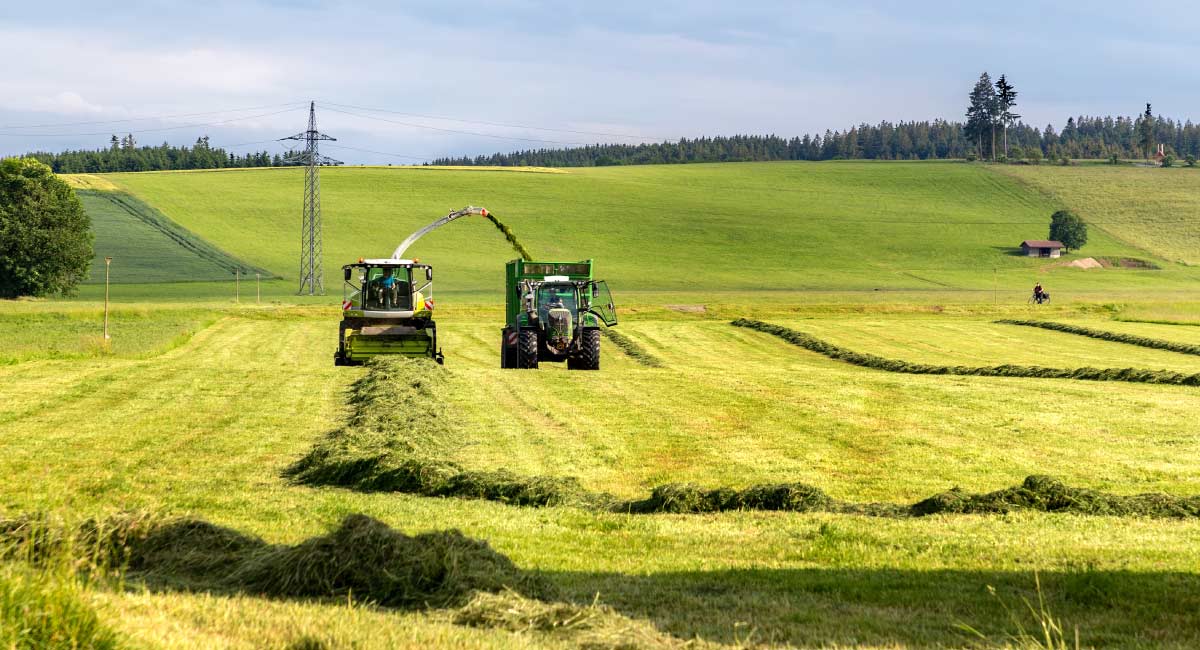Silage is a staple in modern livestock farming, providing a valuable source of nutrition for animals throughout the year.
Whether you’re a seasoned farmer or new to the world of silage, this comprehensive guide will provide the necessary information you need to navigate the whole procedure.
Keep reading to find out what exactly is silage, what equipment you need at every step of the process to create high-quality fodder, how to distribute it effectively, and essential tips to ensure success.
Let’s dive in!
What is silage?
Silage is a type of animal feed made from green forage crops, such as grass, corn, or other plants, that are harvested and then preserved through an anaerobic fermentation process.
It is a method of conserving and storing high-moisture plant material for use as livestock fodder, especially during periods when fresh forage is not readily available, such as in the winter or during times of feed scarcity.
Different types of plants can be used to make silage, with its nutritional quality varying based on factors like the type of forage used, the stage of plant maturity at harvest, and the quality of the fermentation process.

How to make silage – a step-by-step-guide
Silage can provide a reliable source of nutrition for livestock and is particularly useful in regions with distinct seasons.
Here are the main steps to make silage to ensure the best results:
Step #1: Harvesting and shredding
The forage crop is cut while it is still green and in a high-moisture state, often using specialized silage equipment like forage harvesters or mowers.
The harvested forage is then chopped into smaller pieces using compost shredders to facilitate compaction and improve packing density in the storage structure.
Gepalift tip: Use the best-quality forage available, as it directly affects the nutrition of your livestock, and make sure to harvest your crop at the right time, typically when it’s in the vegetative stage with optimal moisture content (about 60-70%).
Step #2: Packing and sealing
The chopped forage is tightly packed into a silo, bunker, or pit.
This compaction helps exclude air, which is essential for the fermentation process. The silo or storage structure is sealed to prevent the entry of oxygen, which can spoil the forage. This is typically done with plastic sheets or other airtight materials.
Gepalift tip: To ensure optimal results, monitor and manage moisture levels during the silage-making process, as well as temperature – cold weather can slow the fermentation process. In any case, periodically inspect your silage to ensure it’s in good condition and free from mold or spoilage.

You may want to know: What is composting and what are its benefits to the environment?
Step #3: Fermentation
The absence of oxygen allows anaerobic bacteria to ferment the forage.
During fermentation, these bacteria convert sugars and other carbohydrates in the forage into organic acids, primarily lactic acid. This drop in pH helps preserve the forage and inhibit the growth of spoilage organisms.
Gepalift tip: Cover the packed silage with a plastic sheet and weigh it down with tires or sandbags. Ensure no air can penetrate the silage and consider using silage additives or inoculants to improve the fermentation process and extend shelf life.

Step #4: Storage and distribution
Once the fermentation process is complete, the silage can be stored for an extended period, often several months or even years, and used as feed for livestock, such as cattle, sheep, and goats.
Gepalift tip: Allow the forage to ferment for several weeks. During this time, lactic acid bacteria will preserve the silage, reducing spoilage.
Whenever you need it, the silage is ready to distribute to your livestock. Invest in appropriate feeding equipment, such as a silage distributor, to deliver silage to your animals. Silage should be distributed promptly to maintain its freshness. Unused silage should be stored correctly to prevent spoilage.
Gepalift tip: Ensure you distribute the right quantity of silage according to the nutritional needs of your livestock. Consult with a nutritionist if necessary.
Advantages and disadvantages of silage
Typical advantages of silage, other than immediate access to livestock fodder throughout the year, include high yields per acre (especially corn silage), reduced field losses, flexible harvesting dates, and efficient use of labor.
By combining different types of crops, such as corn or grass, you can schedule harvesting at different maturities and spread labor over an entire season.
The main silage disadvantage has to do with spoilage. You need to be extra careful with moisture content, make sure you have adequate space, and that your silage is packed correctly, preventing exposure to oxygen. Poor silage quality can reduce feed quality and milk production, or even cause health issues, so it’s important to ensure proper sealing for the fermentation process to take place.

Final thoughts on silage production
Mastering silage production is essential for the success of your livestock farming operation.
By investing in the right silage equipment, following best practices for creating and distributing silage, and keeping Gepalift’s essential tips in mind, you’ll ensure a consistent and high-quality feed source for your animals year-round.
Proper silage management will result in healthier and more productive livestock, making it a crucial component of modern farming practices.
If you want to know more about the process or the proper silage machinery needed, get in touch with Gepalift.
We’d be happy to assist you!


